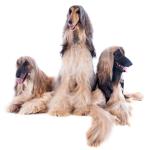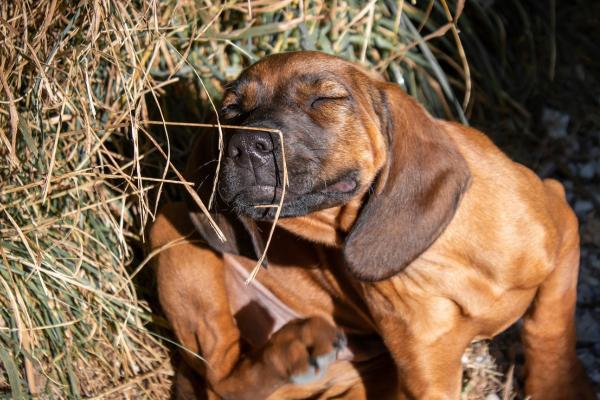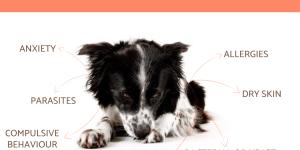Why Is My Dog Rubbing Their Nose Raw?



See files for Dogs
A dog will rub their nose regularly for various reasons, but it is not common for them to do so until it is raw. When they do this, it means there is something which is agitating them to the point they will cause a wound to appear. If causing an open wound is better than the sensation that exists, we can assume the problem is quite acute. The cause of the nose rubbing is often localized to the facial area of the dog, but it is also possible a sign of a more generalized problem.
At AnimalWised, we ask why is my dog rubbing their nose raw? We look at the reasons why dogs scratch their nose until they cause an open wound, as well as what treatment options may be available.
Dog allergies that produce an itchy nose
When a dog has allergies, it can cause itchiness and irritation on their nose, leading them to scratch excessively. Allergies trigger an immune response. In doing so, the body releases histamines, which can result in inflamed and itchy skin. If the allergen comes into contact with the dog's nose, it can cause localized itching and discomfort, leading the dog to scratch their nose raw.
Dogs may not stop scratching on their own if they have allergies, as the itchiness can be persistent. Rubbing temporarily relieves the discomfort, but it can also exacerbate the irritation and lead to raw, damaged skin.
The treatment for allergies in dogs involves addressing the underlying cause and managing the symptoms. This should stop the dog rubbing their nose raw. Here are some common approaches:
- Avoidance of allergens: if the allergen can be identified, minimizing or eliminating exposure to it can help prevent allergic reactions. However, this may not always be possible if the allergen is widespread or difficult to identify.
- Antihistamines: veterinarians may prescribe antihistamines to reduce the histamine response and alleviate itching. However, not all dogs respond well to antihistamines, and the effectiveness varies among individuals.
- Topical treatments: topical creams, ointments, or sprays can be applied to soothe the irritated skin and reduce itching. These treatments may contain corticosteroids or other anti-inflammatory ingredients.
- Immunotherapy: in some cases, veterinarians may recommend immunotherapy (allergy shots) to desensitize the dog's immune system to specific allergens over time. This approach can provide long-term relief for some dogs with allergies.
- Fatty acid supplements: adding omega-3 fatty acid supplements to the dog's diet can help improve the skin's health and reduce inflammation. You can also consider including foods rich in omega-3 into their diet.
- Environmental management: keeping the dog's living environment clean and free from potential allergens can help reduce exposure and minimize allergic reactions.
It's crucial to consult with a veterinarian if you suspect your dog has allergies and is scratching their nose raw. The vet can conduct tests to identify specific allergens and develop a tailored treatment plan to manage the allergies effectively. Additionally, addressing the allergies promptly can help prevent secondary skin infections resulting from continuous rubbing and rawness.
Skin infections
When a dog has an infection on their nose, it can cause itchiness, irritation and discomfort. These sensations can lead them to scratch excessively. Infections can be caused by bacteria, fungi or viruses. They can result from various factors, such as wounds, bites or underlying health conditions. Infections often trigger an inflammatory response, which leads to redness, swelling and itching in the affected area.
Types of infections that can affect a dog's nose
- Bacterial infections: bacterial infections can occur from a wound, scratch, or bite on the nose. The bacteria can cause localized inflammation and irritation, leading the dog to scratch at the affected area.
- Fungal infections: fungi such as yeast can also cause infections on the nose and surrounding skin. Fungal infections can be itchy and uncomfortable, prompting the dog to scratch to relieve the itching sensation.
- Viral infections: certain viral infections such as canine distemper can cause nasal discharge and inflammation. The dog may scratch their nose in response to the discomfort caused by the infection.
- Parasitic infections: parasites such as mites or ticks can infest the nose and cause irritation, leading to rubbing.
Treatment for infections to stop the dog from scratching their nose raw
Treating the infection is essential to alleviate the itchiness and discomfort that lead the dog to scratch their nose raw. Here's how treatment can help:
- Antibiotics or antifungal medication: depending on the type of infection, the veterinarian may prescribe antibiotics or antifungal medication to combat the underlying cause of the infection. These medications help clear the infection and reduce inflammation, ultimately reducing the dog's itchiness.
- Topical treatments: topical ointments or creams may be applied to the affected area to soothe the skin and reduce itching. These treatments may contain anti-inflammatory ingredients to alleviate discomfort.
- Cleaning and wound care: keeping the affected area clean and dry is crucial for the healing process. The veterinarian may provide instructions for proper wound care to prevent further irritation.
- Pain management: if the dog is experiencing pain or discomfort from the infection, pain management measures may be used to keep them comfortable and reduce the urge to scratch.
- Addressing underlying health issues: if the infection is a result of an underlying health condition, addressing that condition is necessary to prevent recurring infections.
By addressing the infection and providing appropriate treatment, the dog's itchiness and discomfort can be reduced, leading to a decreased desire to scratch their nose raw. Regular follow-ups with the veterinarian are essential to monitor the progress of healing and ensure the infection resolves completely.

Dental problems
A dog may scratch their nose due to dental problems, particularly if the dental issues are causing referred pain or discomfort to the surrounding areas. Dental problems can lead to various discomforts, and dogs may exhibit unusual behaviors, including nose rubbing, as a response to the pain or irritation. Some dental problems that can cause nose scratching include:
- Dental abscess: an abscess in dogs is a painful infection that can develop in the roots of a tooth or in the surrounding gum tissue. The pain from a dental abscess can radiate to the nose area, leading the dog to scratch as they try to alleviate the discomfort. In addition to the tooth, abscesses can occur on the dog's gums.
- Gum disease (periodontal disease): advanced gum disease can cause inflammation and pain in the gums, teeth, and surrounding tissues. Dogs may scratch their nose in response to the discomfort caused by gum disease.
- Broken or fractured teeth: broken or fractured teeth can expose sensitive nerve endings, causing pain and discomfort. The pain may be felt in the entire mouth area, leading to nose scratching.
- Tooth decay: tooth decay in dogs leads to cavities which can cause sensitivity and pain in the affected teeth. The pain can radiate to the nose area, leading the dog to scratch.
- Dental malocclusions: misaligned or maloccluded teeth can cause pressure and discomfort in the mouth, leading the dog to scratch the nose area as they attempt to relieve the pain.
Treatment options for dental problems causing nose scratching
Treating dental problems is essential to alleviate the pain and discomfort that may lead to nose rubbing. Here are some treatment options:
- Dental cleaning: for mild cases of gum disease or tartar buildup, a professional dental cleaning may be necessary to remove plaque and tartar from the teeth and gums.
- Tooth extraction: in cases of severely damaged or infected teeth, extraction may be necessary to eliminate the source of pain.
- Root canal treatment: for certain dental abscesses or infections, a root canal may be performed to save the affected tooth and alleviate the pain.
- Pain medication: pain medication or anti-inflammatory drugs may be prescribed by the veterinarian to relieve pain and discomfort associated with dental problems.
- Dental X-rays: X-rays may be taken to assess the extent of dental issues and to identify any hidden problems below the gum line.
- Home dental care: regular brushing of the dog's teeth and providing dental treats or toys can help prevent and manage dental problems.
It's crucial to have a veterinarian evaluate the dog's dental health if nose scratching is suspected to be related to dental issues. Early detection and proper dental care can prevent complications and improve the dog's overall oral health and wellbeing.
Foreign bodies
Foreign objects or substances can cause a dog to rub their nose raw through irritation and discomfort. When a foreign body becomes lodged in the nasal passages or comes into contact with the sensitive tissues of the nose, it can trigger inflammation, pain and itching. The dog's natural response is a reflex action to scratch at the affected area in an attempt to alleviate the discomfort or remove the foreign object.
Treatment options for foreign bodies causing nose scratching
Treatment for foreign bodies in the nose aims to safely remove the object or substance causing the irritation. Here are some treatment options:
- Professional extraction: in cases where the foreign body is visible and reachable, a veterinarian may use specialized instruments to gently extract the object from the nasal passages. We should not try to remove the foreign body on our own since this can cause more damage, especially if it is lodged deep in the tissue.
- Sedation or anesthesia: if the foreign body is deeply lodged or difficult to reach, the dog may require sedation or anesthesia to facilitate its safe removal.
- Irrigation: in some instances, flushing the nasal passages with a saline solution may help dislodge smaller foreign bodies.
- Endoscopy: for certain cases, an endoscope (a flexible tube with a camera) may be used to visualize the nasal passages and guide the removal of the foreign body.
- Pain management: if the dog is experiencing pain or discomfort due to the foreign body, pain management measures may be used to keep them comfortable and reduce the urge to scratch.
Prompt veterinary evaluation is crucial when a foreign body is suspected in the dog's nose. Attempting to remove the object yourself can be dangerous and may push the foreign body further into the nasal passages. A veterinarian will be able to safely and effectively remove the foreign body and provide appropriate treatment to ensure the dog's nose heals properly and reduces the urge to scratch.
Learn more about how long it takes a dog to pass a foreign body in our related article.

Respiratory diseases and sinus infections
Sinus infections and other respiratory diseases can cause a dog to scratch their nose raw due to the discomfort and irritation they experience. Respiratory infections and conditions in dogs can lead to nasal congestion, inflammation, and itching, prompting the dog to scratch their nose in an attempt to relieve the symptoms.
Respiratory diseases that can cause nose scratching
Sinusitis: sinusitis is the inflammation of the sinuses, which are air-filled cavities around the nose and eyes. A bacterial or viral infection can cause sinusitis in dogs, leading to symptoms such as nasal discharge, sneezing, nasal congestion, and itching. The itching can cause the dog to scratch their nose raw.
Rhinitis: rhinitis in dogs refers to the inflammation of the nasal lining. Allergies, irritants, or infections can cause rhinitis in dogs, leading to nasal discharge, sneezing, and itching.
Canine distemper: canine distemper is a highly contagious viral disease that affects a dog's respiratory and nervous systems. It can cause nasal discharge, congestion, coughing, and itching of the nose.
Kennel cough: kennel cough is a contagious respiratory disease primarily caused by the Bordetella bronchiseptica bacterium. It leads to coughing, nasal discharge, and throat irritation, which can cause nose rubbing.
Treatment options for respiratory diseases causing nose scratching
The treatment for respiratory diseases in dogs aims to address the underlying cause, alleviate symptoms, and prevent complications. Here are some treatment options:
- Antibiotics or antiviral medications: if the respiratory disease is caused by a bacterial or viral infection, antibiotics or antiviral medications may be prescribed to target the specific pathogen. In mild infections, these medications are not usually administered as the dog's immune system can often deal it with alone.
- Anti-inflammatory medications: anti-inflammatory drugs may be given to reduce inflammation in the nasal passages and ease discomfort.
- Cough suppressants: in cases of the dog persistently coughing, cough suppressants may be used to alleviate throat irritation and reduce the urge to scratch the nose.
- Nasal Irrigation: for certain respiratory conditions, nasal irrigation with a saline solution may be recommended to clear the nasal passages and promote drainage.
- Supportive care: providing a comfortable and quiet environment for the dog to rest can aid in the recovery process. Adequate hydration and proper nutrition are also essential.
- Isolation and quarantine: for contagious respiratory diseases, isolating the infected dog from other dogs is crucial to prevent further spread of the disease.
It's essential to consult a veterinarian for a proper diagnosis and treatment plan if a respiratory disease is suspected. Early detection and appropriate management can improve the dog's condition, reduce nose scratching, and prevent potential complications.
This article is purely informative. AnimalWised does not have the authority to prescribe any veterinary treatment or create a diagnosis. We invite you to take your pet to the veterinarian if they are suffering from any condition or pain.
If you want to read similar articles to Why Is My Dog Rubbing Their Nose Raw?, we recommend you visit our Other health problems category.






